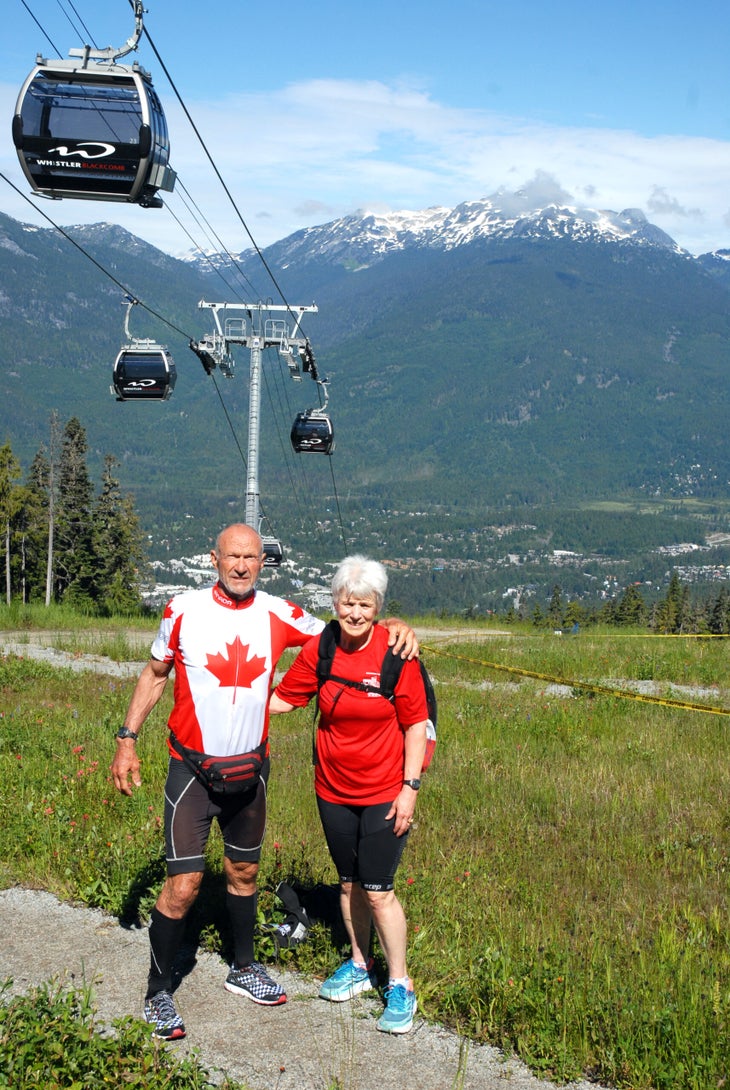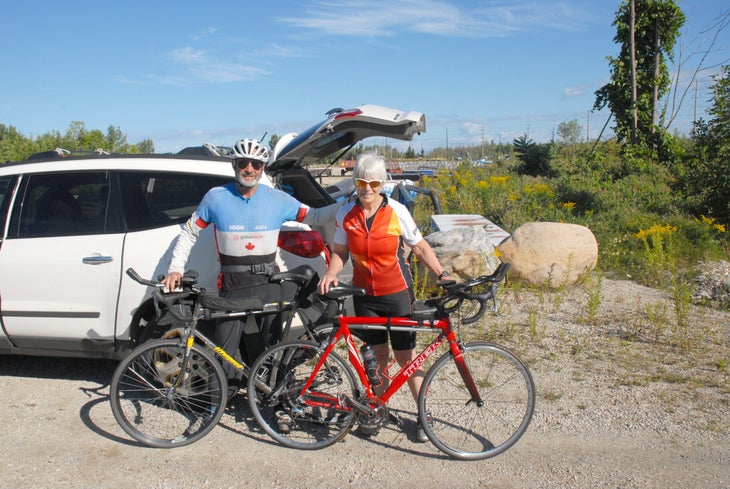New perk! Get after it with local recommendations just for you. Discover nearby events, routes out your door, and hidden gems when you sign up for the Local Running Drop.
Canadians John Wragg, 72, and Elizabeth Model, 63, met in 2006 exactly how you’d expect: at the finish line of an Ironman.
Since their chance meeting at Ironman Arizona nearly 20 years ago, the pair have traveled the world, completing at least one Ironman on six of the seven continents and running a marathon on every continent. Together, they have more than 400 Ironman finishes.
In speaking with the globetrotting couple from their hotel room in Israel as Wragg and Model prepared for the inaugural running of Ironman Israel (both would later pull out of the race due to illness), it’s clear that Ironman isn’t an event to Wragg and Model, it is a way of life.
The Origin Story
Wragg has been fit his whole life, dabbling in bodybuilding and running in his college years. He has always looked at athletics as a way to challenge himself and took part in his first Ironman in 1988 as part of the 10th anniversary of Ironman Hawaii (now fondly referred to as simply, “Kona” in the tri scene).
“In 1988 there were only five Ironman races worldwide,” Wragg said. “Kona, Hawaii, Lake Biwa, Japan, Auckland, New Zealand, Roth, Germany, and Penticton, British Columbia…very different from today.”
Wragg was one of the first advocates for more Ironman races available domestically in the USA and Canada. He worked with Graham Fraser, who eventually created the original Ironman Florida, Ironman Lake Placid, Ironman Coeur D’Alene, and Ironman Arizona in the 1990s. Since then, Fraser and his wife have been inducted into the Ironman Hall of Fame.
Model joined the triathlon community a bit later than Wragg, with her first Ironman being Ironman Canada in Penticton in 2005. She was hooked after that first epic finish line, but little did she know the way the sport would captivate her for the next 20-plus years.
“When I met John at Ironman Arizona in 2006 I said, ‘My triathlon club is doing Ironman South Africa next, do you want to join us?’” Model said. “Even in 2006, there were only about 15 Ironmans worldwide, and I wanted to do all of them because that was an attainable number. That began our journey to do every Ironman.”
Since their kismet meeting, Wragg and Model have completed 268 and 105 Ironman-branded races, respectively. Their favorite venues? Ironman Lake Taupo in New Zealand, followed closely by Ironman Austria in Klagenfurt, Austria.

The Logistics
Traveling to locations like Hawaii, New Zealand, Brazil, and Israel with bikes and triathlon gear in tow is no small – or inexpensive – feat.
Surprisingly, Wragg and Model aren’t the beneficiaries of a lush inheritance or stock market pros. Both have led frugal lives with deliberate financial decisions to allow the two to do what they love most: swim, bike, and run.
“I still work full time,” Model said. “I’m a CEO of an organization in Canada and I work hard to negotiate time off – but with that comes working massive overtime. For example, I took a call at 4:30 a.m. IST this week to stay up-to-date with my business while in Israel.”
Model went on to say that the pair is “very careful” with how they travel and how they live their lives at home.
“We put our money into Ironman races and traveling instead of, say, going out on the town regularly,” Model said. “We don’t stay in five-star hotels or eat at lavish restaurants when we race. We stay in modest accommodations and usually get local groceries and make our own meals when traveling.”
Wragg is a retired physical education teacher, and remembers when Ironman was much more affordable.
“The cost factor [to race an Ironman] has become, in my opinion, outrageous,” Wragg said. “Early on in my triathlon career I would drive to a race and sleep in my car. When I first did Ironman Lake Placid decades ago, I accidentally parked my car on the run course and it was towed and I ended up having to pay to get my car back after the race.”
Wragg noted that he is concerned that Ironman is becoming unattainable financially, which isn’t the spirit of the sport. He hopes that races like the Ironman World Championship remain true to their roots of competition and don’t exist “just for the people who can afford it.”
Despite rising registration and travel costs, Wragg and Model still make their global ambitions work because at the core, what they love is the community of triathletes and the opportunity to travel the world with each other.
“My mother always said take care of your pennies and everything else will take care of itself,” Model said with an affirming nod.
RELATED: Why Is Triathlon So Expensive?

The Present and the Future
Nowadays, Model mostly supports Wragg in his racing. She has largely retired from racing iron-distance events due to injuries. Wragg, too, knows his red carpet finishes may be limited.
“I’m 72, and my mindset has since changed from when I started the sport,” Wragg said. “At one point I did a sub-10-hour Ironman. Now, though, if I can make it in before the 17-hour cutoff, I’m happy.”
Wragg pulled out of the 2022 Ironman World Championship after T1 this year, which he noted was incredibly frustrating, but potentially indicative that it is time for a change.
In fact, the 70.3-distance may be calling Wragg’s name in the near future. “We will eventually graduate ourselves back to the shorter-distance triathlons,” Wragg said. “A 70.3 is great because you finish in say, six hours, you aren’t totally wrecked, and you still have the mental capacity to enjoy the day.”
Model and Wragg have learned a lot in their decades spent globetrotting and triathlon’ing in exotic locations. The veterans are practically oozing advice that applies to both life and sport.
“My mindset is that a positive mental attitude gets you through the day,” Wragg said. “It’s all about who is the toughest mentally. You put one foot in front of the other and remind yourself that you are going to make it, you are going to make it before the cutoff.”
Model shared the same sentiment: “My mantra is ‘Get ‘er done,’” Model said with a smile. “Some days my body responds and sometimes it doesn’t, but no matter what, you grind out a finish and get ‘er done.”
Wragg also noted that one of the keys to his athletic longevity has been “taking a day or two off from training every week.” (Take note, chronic over-trainers.)
Wragg and Model are currently recovering from their overseas journey to Israel (in which one bike got lost, and then was found just in time for the race). They are both looking forward to some rest and recovery this winter back home in Canada before the early 2023 release of their book Go, which they wrote during the pandemic to capture their lifetime of adventure via multisport.
RELATED: Triathlete’s Guide on How to Manage Back-to-Back Races